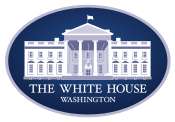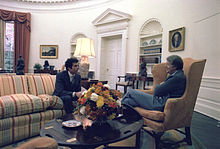White House Chief of Staff
| White House Chief of Staff | |
|---|---|
 | |
since January 25, 2013 | |
| Executive Office of the President White House Office | |
| Reports to | The President |
| Appointer | The President |
| Formation | 1946 (Assistant to the President) 1961 (White House Chief of Staff) |
| First holder | John R. Steelman |
| Succession | None; Cabinet Rank only |
| Website | The White House |
The White House Chief of Staff is the highest ranking employee of the White House Office inside the Executive Office of the President of the United States. The position began as the Assistant to the President in 1946 and acquired its current name in 1961.
The current White House Chief of Staff is Denis McDonough, who assumed the position on January 25, 2013, after Jack Lew resigned in order to accept appointment as Secretary of the Treasury.
History
The duties of White House Chief of Staff vary greatly from one administration to another, and in fact, there is no legal requirement that the President even fill the position. However, since at least 1979, all Presidents have found the need for a Chief of Staff, who typically oversees the actions of the White House staff, manages the president's schedule, and decides who is allowed to meet with the president. Because of these duties, the Chief of Staff has at various times been labeled "The Gatekeeper", or "the power behind the throne".
Originally, the duties now performed by the Chief of Staff belonged to the President's private secretary and were fulfilled by crucial confidants and advisers such as George B. Cortelyou, Joseph Tumulty, and Louis McHenry Howe to presidents Theodore Roosevelt, Woodrow Wilson, and Franklin Roosevelt, respectively.[1] The private secretary served as the President's de facto chief aide in a role that combined personal and professional assignments of highly delicate and demanding natures, requiring great skill and discretion.[2] The job of gatekeeper and overseeing the President's schedule was separately delegated to the Appointments Secretary, as with FDR's aide Edwin "Pa" Watson.
From 1933 to 1939, as he greatly expanded the scope of the federal government's policies and powers in response to the Great Depression, Roosevelt relied on his "Brain Trust" of top advisers. Although working directly for the President, they were often appointed to vacant positions in agencies and departments, whence they drew their salaries since the White House lacked statutory or budgetary authority to create new staff positions. It was not until 1939, during Franklin D. Roosevelt's second term in office, that the foundations of the modern White House staff were created using a formal structure. Roosevelt was able to get Congress to approve the creation of the Executive Office of the President reporting directly to the President which included the White House Office.
In 1946, in response to the rapid growth of the U.S. government's executive branch, the position of Assistant to the President of the United States was established. Charged with the affairs of the White House it was the immediate predecessor to the modern Chief of Staff. It was in 1953, under Republican President Dwight D. Eisenhower, that the president's pre-eminent assistant was designated the White House Chief of Staff.
Assistant to the President became a rank generally shared by the Chief of Staff with such senior aides as Deputy Chiefs of Staff, the White House Counsel, the White House Press Secretary, and others. This new system did not catch on right away. Democrats Kennedy and Johnson still relied on their Appointments Secretaries instead, and it was not until the Nixon administration that the Chief of Staff took over maintenance of the President's schedule. This concentration of power in the Nixon White House (and the criminal activity it enabled) led presidential candidate Jimmy Carter to campaign in 1976 with the promise that he would not appoint a Chief of Staff. And indeed, for the first two and a half years of his presidency, he appointed no one to the post.
The average term of service for a White House Chief of Staff is a little under 2.5 years. John R. Steelman, under Harry S. Truman, was the last Chief of Staff to serve for an entire presidential administration. Steelman also holds the record for longest-serving Chief of Staff (six years). Andrew Card and Sherman Adams tie for second-longest (five years each).
Most White House Chiefs of Staff are former politicians, and many continue their political careers in other senior roles. Lyndon Johnson's Chief of Staff W. Marvin Watson became Postmaster General later in LBJ's term. Richard Nixon's Chief of Staff Alexander Haig became Secretary of State under Reagan. Gerald Ford's Chief of Staff Dick Cheney later became a U.S. Representative for Wyoming, Secretary of Defense under George H. W. Bush, and Vice President under George W. Bush. Donald Rumsfeld was another Chief of Staff for Ford and subsequently served as Secretary of Defense both in the Ford administration and decades later in the George W. Bush administration. Rahm Emanuel left the House of Representatives to become Barack Obama's Chief of Staff and subsequently became mayor of Chicago.
Role
This section needs additional citations for verification. (September 2013) |

The roles of the Chief of Staff are both managerial and advisory and can include the following
- Select key White House staff and supervise them
- Structure the White House staff system
- Control the flow of people into the Oval Office
- Manage the flow of information
- Protect the interests of the President
- Negotiate with Congress, other members of the executive branch, and extragovernmental political groups to implement the President's agenda
- Advise the President on various issues
It is possible that a powerful Chief of Staff with a "hands-off" president (who decides not to become involved in the minutiae of government), can become a de facto Prime Minister. Such prime ministers exist in some governmental systems: The prime minister runs the government (operations-wise), while the president remains somewhat aloof from the political process, but personally handling policy matters. Richard Nixon's first Chief of Staff, H. R. Haldeman, garnered a reputation in Washington for the iron hand he wielded in the position—famously referring to himself as "the President's son-of-a-bitch," he was a rigid gatekeeper who would frequently meet with administration officials in place of the President, then report himself to Nixon on the officials' talking points. Journalist Bob Woodward, in his books All the President's Men and The Secret Man, wrote that many of his sources, including the famous Deep Throat, displayed a genuine fear of Haldeman.[3][4]
Deputy Chiefs of Staff
The Chief of Staff is assisted by one or more Deputy Chiefs of Staff. Under the Obama Administration, these roles are filled by Rob Nabors (replacing Nancy-Ann DeParle), Alyssa Mastromonaco, Anita Decker Breckenridge, replacing Mastromonaco, and Mark B. Childress. During the George W. Bush Administration, Joel Kaplan held this title for Policy. Karl Rove preceded Kaplan in this role until April 19, 2006 when (then-new) Chief of Staff Joshua Bolten added his former Deputy Director of the OMB to the Deputies list. Rove left the White House officially on August 31, 2007. Joe Hagin is the former Deputy Chief of Staff for Operations.
See also
- List of White House Chiefs of Staff
- White House Deputy Chief of Staff
- Chief of Staff to the Vice President of the United States
- Joint Chiefs of Staff
- Kremlin Chief of Staff
References
- ^ "New Quarters". Time. 1934-12-17. Retrieved 2008-05-08.
- ^ "An Appointment". Time. 1923-08-20. Retrieved 2009-05-09.
- ^ Woodward, Bob, and Bernstein, Carl. (1974) All the President's Men. New York: Simon & Schuster. ISBN 978-0-671-21781-5
- ^ Woodward, Bob. (2005). The Secret Man. New York: Simon & Schuster. ISBN 0-7432-8715-0



